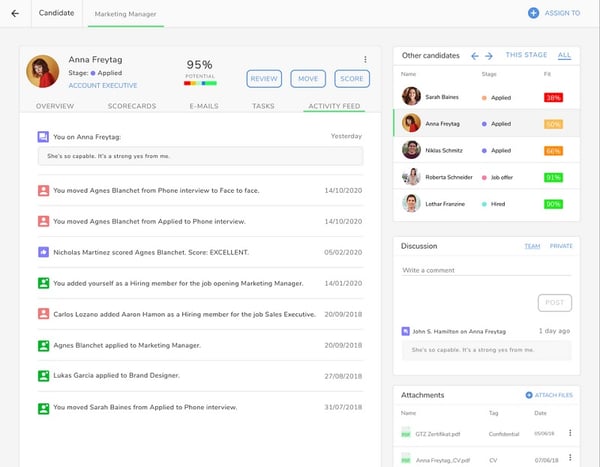In today’s competitive scrum of a labour market, it’s not unusual for a company to receive 200 applications or more for a job opening. This makes CV screening a crucial step in the recruitment and selection process. Only then will the human resources team be able to distinguish qualified candidates from unsuitable applicants and concentrate on finding the best employee.
In this article we will take a look at what it involves, why it is important, the steps you need to follow and how technology can make cv screening more efficient.
What is CV screening?
CV screening is one of the first steps in the staff selection process in which recruiters review all the CVs received and pick out the candidates who satisfy the minimum job requirements.
The task has two main goals:
- To narrow down the number of candidates for the position.
- To single out the ones with interesting profiles.
Candidate screening can be done manually, but it is time intensive and increases the risk of a good candidate slipping through the net. The other option is to use an applicant tracking system (ATS). This is a programme that acts as a resume database and allows us to filter or search by relevant keywords.
Why do we need to screen resumes?
CV screening not only allows us to reduce the number of applications, but to focus our energies on genuinely interesting applicants during the selection process.
A bad hiring decision has major time and cost implications for employers. If an employee does not live up to expectations, the cost can be the equivalent of 30% of their annual salary (according to HR Exchange).
On the other hand, getting it right with a new signing has a hugely positive impact on the organisation: it boosts productivity, improves the work environment, and leads to a marked decrease in the staff turnover rate.

The stages of CV screening
What’s the best way to implement an HR screening process? Every company will have their own methods, but these are some of the key steps:
1. Identify the business needs
Whether you need to fill an existing vacancy, or it is a new position altogether, the first step is the same: analyse the company’s specific needs. It is essential to understand what the employee’s duties and strategic goals would be in this role to compose a good description.
2. Define the job requirements
Before you start to filter CVs, write down the requirements or skills you are looking for among the candidates. Some of the most relevant aspects include:
- Essential skills: make a brief list of the necessary skills so you can easily reject those who don’t meet the criteria.
- Minimum experience: specify the minimum experience the candidate needs to have in different areas and how long for. For example, at least three years’ team management experience.
- Desirables: also consider skills or expertise that could be interesting but are not essential for the position.
Don’t forget to include all deal-breaker specifics for candidate selection such as location, start date, etc. It’s common, for example, to reject applicants who don’t live in the same city.
3. Do a quick screen
Colin Gordon recommends doing a quick first screen by looking at the CVs and leaving those without the essential criteria to one side. This will usually reduce the volume of applications considerably.
4. Divide the CVs into “yes” and “maybe”
Take another look at the CVs you have selected, paying more attention to the details and separate them into two piles: the yes pile will include CVs that appear to fulfil all the necessary requirements for the position and contain some extra interesting skills; assign the ones that only satisfy some of the requirements to the maybe pile.
5. Focus on the small details
Look closely at the CVs in your “yes” pile. Is the presentation good? Does the person seem organised? Are there any typos or grammatical errors? Analyse their work history in general, etc.
 Kenjo Interface
Kenjo Interface
6. Ask the manager to review
Show your CV shortlist to the team manager of the department with the vacancy to see if they fit the job requirements. Their feedback will help you decide if you need to revisit the rejections or move forward with the process.
7. Call the candidates
Your first contact with the candidates should be by telephone to tell them more about the opening and gather additional information. If the conversation goes well, you can invite them to a first interview.
8. Hold the interview
Having made it through the screening process, the interview is one of the last obstacles for candidates. The goals here are to get to know the applicants in person, analyse their soft skills and understand their career history better.
How can technology help with this process?
An applicant tracking system (ATS) can save the human resources specialists hours in steps 3, 4 and 5 mentioned above. Instead, they only need to enter key search terms or use filters such as: education level, languages, location, technical skills, etc. This data will provide a list of the best candidates to use as a starting point.
And the advantages of using technology for CV screening don’t stop there. You can also:
- Save the company time and money by reducing the time to hire.
- Help the human resources team to find the best candidates.
- Centralise all information on a single platform and use it as a talent pool.
- Encourage transparency and fairer selection processes.
- Manage the whole selection process from a single tool and create your own workflows.


 Kenjo Interface
Kenjo Interface